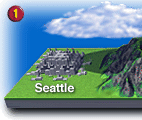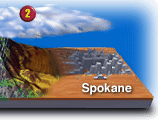
Water,
Climate, and Vegetation
Objectives
![]() Describe how the water of
the earth moves in a cycle.
Describe how the water of
the earth moves in a cycle.
![]() Investigate what climate is and the factors that influence climate.
Investigate what climate is and the factors that influence climate.
![]() Identify each major climate region.
Identify each major climate region.
Chapter
Overview
Chapter 2: Water, Climate, and Vegetation
Water covers about 70 percent of the earth's surface. The earth's water
is continually moving though the processes of evaporation, condensation,
precipitation, and collection. Together these steps are known as the water
cycle. In order to survive humans need freshwater, but the vast majority
of the water on Earth is the saltwater found in the oceans.
Climate is the usual pattern of weather in an area over a long period of
time. A combination of factors creates climate. Wind and ocean currents,
the sun, latitude, and elevation all contribute to climate. People's actions
can also affect climate. The burning of fossil fuels and the destruction
of the rain forest are human actions that are causing concern.
Geographers divide the world into different climate zones. Each zone shares
common characteristics and has particular kinds of vegetation. The four
major climate zones are tropical, mid-latitude, high latitude, and dry.
![]() Water Cycle Link
Water Cycle Link
![]() Rain Shadow Information:
Rain Shadow Information:
Source: USA TODAY research by Brian Brinch; graphic by John Herne
![]() How
mountains influence rainfall patterns
How
mountains influence rainfall patterns
As air ascends mountains, such as the
Washington Cascades, it is forced to rise. The rising air
cools, condenses, and drops rain on locations situated on
the windward slopes, like Seattle. When the air descends the
back side of the mountain toward Spokane, it is compressed,
warming and drying it out. This sinking, dry air produces a
rain shadow, or area in the lee of a mountain with less rain
and cloudcover.
Where was I June 24, 2003? In this storm in South Dakota!!!
Chase day pictures from June 24, 2003!!!
Quick Notes
Earth's Water
![]() Water constantly moves in a cycle from ocean, to air, to land, and back
to oceans.
Water constantly moves in a cycle from ocean, to air, to land, and back
to oceans.
![]() Rivers and lakes provide important sources of freshwater.
Rivers and lakes provide important sources of freshwater.
![]() Freshwater also is stored in the earth's underground layers of rock.
Freshwater also is stored in the earth's underground layers of rock.
![]() The world's four oceans are the Atlantic Ocean, Pacific Ocean, Indian Ocean,
and Arctic Ocean.
The world's four oceans are the Atlantic Ocean, Pacific Ocean, Indian Ocean,
and Arctic Ocean.
Influences on Climate
![]() The kind of climate a place has depends mainly on its latitude.
The kind of climate a place has depends mainly on its latitude.
![]() Land forms and nearby bodies of water also influence climate.
Land forms and nearby bodies of water also influence climate.
![]() Air and water move around the earth as warm or cold winds and currents.
Air and water move around the earth as warm or cold winds and currents.
![]() A large body of water keeps nearby land temperatures moderate.
A large body of water keeps nearby land temperatures moderate.
![]() Areas in a rain shadow behind coastal mountains often have dry climates.
Areas in a rain shadow behind coastal mountains often have dry climates.
Climate and Vegetation
![]() Four major climate regions are tropical, mid-latitude, high latitude, and
dry.
Four major climate regions are tropical, mid-latitude, high latitude, and
dry.
![]() Tropical climates can be wet, with rain forests, or dry with savannas.
Tropical climates can be wet, with rain forests, or dry with savannas.
![]() In the mid-latitude region, climate is affected by distance from the ocean.
In the mid-latitude region, climate is affected by distance from the ocean.
![]() Places with high latitude climates do not have much vegetation.
Places with high latitude climates do not have much vegetation.
![]() Tropical Climates
Tropical Climates
Tropical Rain Forest Climates
In some parts of the tropics, the growing season lasts all year long. In
these areas, rain and heat produce lush vegetation and dense forests called
rain forests. These forests are home to millions of kinds of plant and
animal life. Tall hardwood trees such as mahogany, teak, and ebony form
the canopy, or top layer, of the forest. The vegetation at the canopy layer
is so thick that little sunlight reaches the forest floor. The Amazon River
basin in South America is the world's largest rain forest area.
Tropical Savannah Climate
In other parts of the tropics, such as southern India and eastern Africa,
most of the year's rain falls during the wet season. The rest of the year
is hot and dry. Savannas, or broad grasslands with few trees, occur in
this climate region.
![]() Mid-Latitude Climates
Mid-Latitude Climates
Marine West Coast Climate
Coastal areas, where winds blow from the ocean, usually have a mild marine
west coast climate. If you lived in one of these areas, your winters would
be rainy and mild, and your summers cool.
Mediterranean Climate
Another mid-latitude coastal climate is called a Mediterranean climate
because it is similar to the climate found around the Mediterranean Sea.
This climate has mild, rainy winters and hot, dry summers.
Humid Continental Climate
If you live far from the oceans in inland areas of North America, Europe,
or Asia, you face a harsher humid continental climate. In these areas,
winters can be long, cold, and snowy. Summers are short but may be very
hot.
Humid Subtropical Climate
Mid-latitude regions close to the tropics have a humid subtropical climate.
Rain falls throughout the year but is heaviest during the hot and humid
summer months. Humid subtropical winters are generally short and mild.
![]() High Latitude Climates
High Latitude Climates
Subarctic Climate
Just below the Arctic Circle lie the subarctic areas. The few people living
here face severely cold and bitter winters, but temperatures do rise above
freezing during the summer months. Huge evergreen forests grow in the subarctic
region, especially in northern Russia.
Tundra Climate
The climate of the Arctic tundra area is harsh and dry. The tundra is a
vast rolling plain without trees. The top few inches of the ground thaw
during the summer months, however. This allows sturdy grasses, small berry
bushes, and wildflowers to sprout. In parts of the tundra and subarctic
regions, the lower layers of soil are known as permafrost because they
stay permanently frozen.
Ice Cap Climate
On the polar ice caps and the great ice sheets of Antarctica and Greenland,
the climate is bitterly cold. Monthly temperatures average below freezing.
Temperatures in Antarctica have been measured at -128ºF (-103ºC)! Although
no vegetation grows here, some fungus-like plants can live on rocks.
Highland Climates
A highland, or mountainous, climate has cool or cold temperatures year-round.
The elevation, or height above sea level, of a place changes its climate
dramatically. Higher into the mountains, the air becomes thinner. It cannot
hold the heat from the sun, so the temperature drops. Even in the tropics,
snow covers the peaks of high mountains. On those peaks, you come to the
timberline, the elevation above which no trees grow. Beyond the timberline,
only small shrubs and wildflowers grow in meadows.
![]() Dry Climates
Dry Climates
Desert Climate
You can find dry climate regions at any latitude. The driest, with less
than 10 inches (25 cm) of rainfall a year, are called deserts. Only scattered
plants such as cacti can survive the dry desert climate. With roots close
to the surface, cacti can collect any rainfall.
Steppe Climate
Many deserts are surrounded by partly dry grasslands known as steppes.
They get more rain than deserts, averaging 10 to 20 inches (25 to 51 cm)
a year. Bushes and short grasses cover the steppe landscape.
1999-2006 © Hokanson's Social Studies




